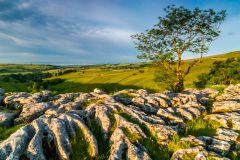
Malham Cove is a stunning, semi-circular cliff on the southern edge of the Yorkshire Dales. The Cove is 80 metres high, and approximately 300 metres wide. It was formed by the action of water from nearby Malham Tarn rushing over a carboniferous limestone cliff, and wearing away the stone more in the centre of the cliff to form a wide curve.
The face of the cliff is marked by long, dark, vertical stripes, from lichen that has taken hold on the stone where water seeps down the slope. The top of the Cove is an area of deep horizontal fissures, called limestone pavement, the result of acidic rain acting on the softer limestone. The high tufts of limestone are known as clints, and the fissure between the clints is known as a gryke. These grykes are the habitat of shade-loving plants, such as ferns.
Malham Cove is reached by a lovely, mostly level footpath from Malham village. A set of steps runs up the side of the Cove, allowing visitors with a bit of ambition and decent fitness to climb to the top for magnificent views over the surrounding Yorkshire Dales countryside.
In addition, Malham Cove is popular among birdwatchers, as there is a local population of peregrine falcons.
The RSPB and Yorkshire Dales National Park operate a free falcon watching station at the base of the Scar.
There are free telescopes available and wardens on hand to help you spot the falcons. The falcon station generally operates daily from early April until the end of August.
About Malham Cove
Address: Malham,
Yorkshire Dales,
Yorkshire,
England
Attraction Type: Countryside
Location: Accessible by footpath from Malham village. Well signposted. Good footwear advisable in wet weather.
Location map
OS: SD898628
Photo Credit: David Ross and Britain Express
HERITAGE
 We've 'tagged' this attraction information to help you find related historic attractions and learn more about major time periods mentioned.
We've 'tagged' this attraction information to help you find related historic attractions and learn more about major time periods mentioned.
Find other attractions tagged with:
NEARBY HISTORIC ATTRACTIONS
Heritage Rated from 1- 5 (low to exceptional) on historic interest
Janet's Foss - 0.9 miles (Countryside) ![]()
Gordale Scar - 1.3 miles (Countryside) ![]()
Winskill Stones Nature Reserve - 4.5 miles (Countryside) ![]()
Catrigg Force Waterfall - 4.9 miles (Countryside) ![]()
Skipton Castle - 8.6 miles (Castle) ![]()
Bracewell, St Michael's Church - 9.2 miles (Historic Church) ![]()
Gisburn, St Mary's Church - 9.7 miles (Historic Church) ![]()
Barden Tower - 10 miles (Castle) ![]()










